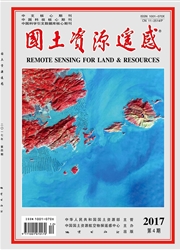

 中文摘要:
中文摘要:
加权滤波经验模式分解(weighted filter empirical mode decomposition,WFEMD)作为一种新的多尺度、多分辨率分析方法,与小波、超小波和现有二维经验模式分解方法相比,更加适合于二维图像中的细节特征分析。该方法运用自适应加权滤波器直接求取均值面,解决了传统二维经验模式分解( empirical mode decomposition,EMD)方法的固有缺陷;将WFEMD方法引入遥感图像融合,能够更好地提取原始图像的特征,为图像融合提供更多的信息。鉴于此,提出了一种基于WFEMD变换的图像融合方法。首先,利用WFEMD的自适应性、多尺度性和高频细节信息的强获取能力,将待融合的图像分别进行WFEMD分解,对不同图像的内涵模式分量( intrinsic mode functions, IMF)按照该文提出的细节/背景原则进行融合,剩余分量按照平均原则进行融合。最后,将融合后的内涵模式分量重构,获取融合图像。实验证明,该方法的融合效果优于其他图像融合方法。
 英文摘要:
英文摘要:
Weighted filter empirical mode decomposition( WFEMD) , as a new multi-scale and multi-resolution analysis algorithm, is more appropriate for the analysis of the image details than wavelet, super wavelet and dimensional empirical mode decomposition, and can solve the inherent defects of the traditional two-dimensional empirical mode decomposition( EMD) . The main reason is that it directly computes the mean envelope by adaptive weighted mean filter. When WFEMD is introduced to the remote sensing image fusion, the characteristics of original images can be better extracted, and more information for fusion can be obtained. Firstly, the source images are decomposed by using WFEMD with the capability of acquirement of the high frequency data, the adaptability for some intrinsic mode functions ( IMF) and the residual component, and then the IMFs and the residual component are fused with the details/background and average fusion regularity respectively at the corresponding scales. Finally, the fused IMFs and the residual component are reconstructed to obtain fusion results. Experiments have shown that the proposed algorithm is efficient in image fusion and is better than other current algorithms.
 同期刊论文项目
同期刊论文项目
 同项目期刊论文
同项目期刊论文
 期刊信息
期刊信息
